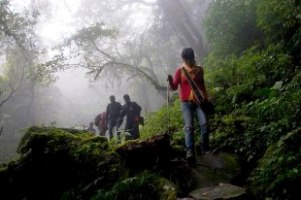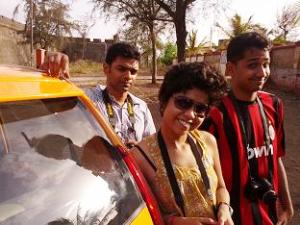One of the great things about having worked in citizen journalism is that I got the chance to meet people like Shibayan Raha, the crusading founder and (as of last time I spoke to him, anyway) sole full-time employee at the Seven Sisters Project, an audio social network that covers India’s Northeastern states.
The NE is one of the most difficult areas of the country for a journalist – or anyone, including health workers and politicians – to navigate. In some tribal areas of Mizoram, Raha told me, voter turn out is as high as 90 per cent (overall totals for Mizoram are lower). But it’s hard to tell, from the way people live, that they are participants in the political process. Again, Raha told me, “in Mizoram you’ll only find a bus in the capital. In Western Mizoram where the minority Chakma community – Buddhist – lives, you can only go in country-made boats.” In the narrow communities where he works, many people have never interacted with regional media, much less national media.
In a paper for the Reuters Institute, reporter Arijit Sen (who has covered the NE extensively) wrote:
“The engagement of the mainstream Indian private media – both print and broadcast – with the Northeast remains marginal. This fact becomes even starker when compared to the extensive coverage that events, even conflicts in the rest of the country (or ‘mainland’ India) receive. The result of this disengagement is that voices from the Northeast find very little space in newspapers and even less air-time in privately owned television news channels that are printed or aired out of metropolitan centres such as New Delhi, Bombay, Bangalore, Chennai or Calcutta. And often, the coverage of the Northeast remains trapped in stereotypes.”
Raha says he ran into these stereotypes often while traveling in the NE. People from other parts of India often saw all of the Northeast as a dangerous and lawless land, a mix of the Wild West and something out of Conrad’s “Heart of Darkness.”
An activist who had spent time working in digital inclusion, Raha came across the stories of entrepreneurs like Aadi Seth of Gram Vaani, who used interactive voice response technology to build social networks in rural India. In June 2013, Raha contracted with GV to use the same technology to put together an IVR-based network in the Northeastern states. These networks operate simply: users call a number and hang up (the famous ‘missed call.’) An automated server calls the user back and plays a menu of options. Users can navigate through the menu using their keypad, and either listen to other people’s content or record their own stories. They can respond to prompts, or leave their own messages.
When we spoke, Raha said Seven Sisters had some 25k users and fielded 900 calls a day. Many of the messages were recorded in native Gorkha or Chakma languages, which were translated for the Seven Sisters webpage by volunteers.
Financially, journalistically, IVR-based networks fill a series of gaps, which has been both a blessing and a curse when it comes to figuring out where they fit. One of the originators of the genre (and a personal friend) is the former BBC journalist Shu Choudhary, who started CGNet Swara with the goal of addressing the massive imbalance in India’s media access. Choudhary is a Knight International Journalism Fellow and, most recently, winner of the Digital Activism Award, 2014. CGNet workers are currently going on a tour of rural villages, staging puppet shows and programs to show people how to generate content “by the people, for the people.”
Although these clips often contain very compelling stories, it’s a challenge for journalists who work in audio-visual media to figure out how to use them. As one co-worker put it to me after I took charge at CJ Online, “who’s going to listen to a half hour of someone talking in a regional dialect?”
I had a hunch that with the right presentation (for example, in the format of a digital magazine) rural audio content could be made extremely compelling even for urban users. I saw GV and CGNet’s content from a purely journalistic perspective - their clips offered unique insights into the lives of people who lived far outside the media mainstream, insights that weren’t available anywhere else in the media. To bolster this point, the people at Gram Vaani sent me links to a series of recordings they’d solicited on rural-urban migration. I heard people talking about trafficking, about the pains and joys of leaving home. I was hooked. But how to make these clips interesting for people who had smartphones, English and Internet?
At an HH New Delhi hackathon, we assigned a team the task of creating a multimedia project from audio data donated by Gram Vaani. Their results won a lot of admiration, but when the team started speaking to news outlets about a sale, the talks bogged down. The content was too aggressively local. Seth (of Gram Vaani) told me that some of his network’s most popular content is hyperlocal news, but blending hyperlocal and national news has traditionally been a very difficult feat for news outlets to pull off. Meanwhile, gathering national-level data (this granular) would require years of investment and capacity-building.
Gram Vaani’s work and (to a greater extent) CGNet and Seven Sisters’ work, also has its roots in community activism. Activism is a difficult thing to sell to traditional media advertisers, and it’s also a difficult thing for a non-partisan news outlet to address from an editorial standpoint. There is huge social value generated when networks like these (to give two examples) award overdue birth certificates to Chakma tribals or take action against police corruption. But does that mean that the projects ask for CSR funding from corporates, and accept the strings that might be attached? Do they turn to grants, which are irregular and require applications? To charge users is out of the question – not only is the audience price-sensitive, but charging users goes against many founders’ inclusive principles.
Meanwhile, the popularity of the projects has expanded to different domains. Hindustan Unilever, an FMCG company, has started its own network in Bihar, which intercuts film songs with ads for HUL products. This rural network has proven so successful in spreading HUL’s message that the company has stopped all radio advertising. Hemant Bakshi, an exec with HUL, told the Economic Times, “Content and advertising are becoming more linked with each other than they used to be in the past. As we go forward and have richer profiles of our listeners, we can leverage the database and plan customised strategies for our brands.” They also said they’d roped in third parties to produce content for the channel.
Overall, I don’t know where these projects will find a home in India’s increasingly crowded user-generated content space. While at CJ, I had the chance to listen to and interact with a variety of different types of content. The sheer diversity of the content being produced (video, audio, print, multiple languages, online, offline) proved as boggling as mapping this content to the right audience. In many ways, though, this challenge fascinated me, partly because it demonstrated how different the Indian media landscape is from the one I’d known back home in the United States.
Raha, at least, seemed quite savvy about the possibilities that existed at the intersection of media types. On the one hand, he showed his activist roots when he said things like, “impact will be when these people can live fearlessly.” But on the other, he was canny about understanding how modern online media is consumed. He told me that Seven Sisters wanted to produce content for their website that is similar to “what BuzzFeed does” – he gave the example of a list “Ten things People from the Northeast are sick of hearing”. The idea would be to use a meme-y format to address serious issues like racial stereotyping.
In the few years since Choudhary first launched his project, IVR-based networks have shown traction and resilience. In many ways, they capture a side of India that no other media manage to capture. In others, they address several problems: diversity of language, lack of media access, low technology penetration. They generate social value, and are well on their way to generating financial value. These networks are already a great Indian social innovation. If we can find a way to bridge the gap between audio/other genres, there’s real potential that these networks can demonstrate value even outside of the hyper-local, non-connected, activist demographic.







































